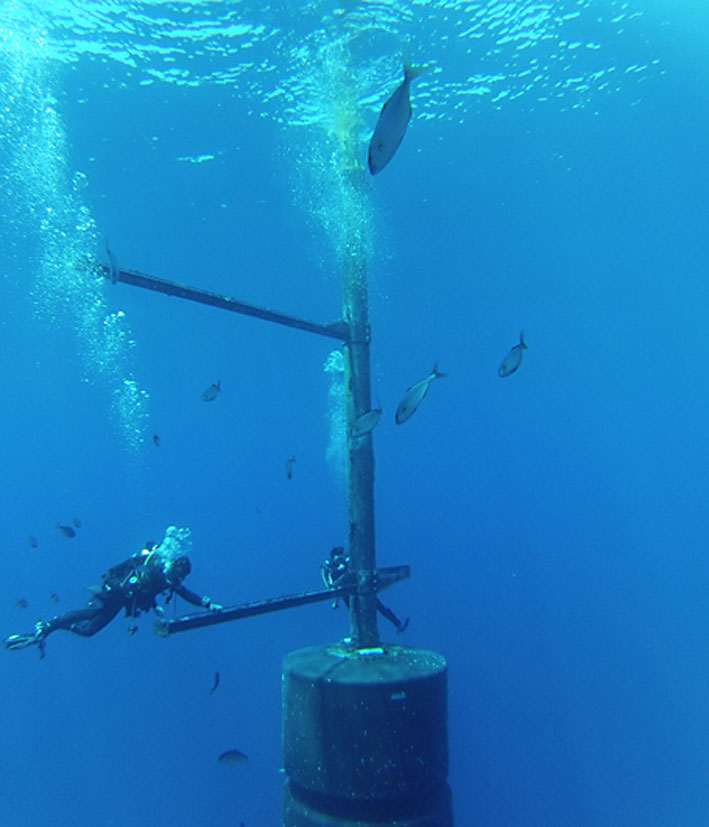Activities
The observations carried out at Lampedusa Atmospheric Observatory are directed mainly to study:- the evolution of the atmospheric concentration of several greenhouse gases;
- the radiative budget of the atmosphere, and the factors that may affect it.
The first activity is aimed at the long term characterization of the atmosphere composition, and in particular to the monitoring of main greenhouse gases like carbon dioxide (CO2), methane (CH4), nitrous oxide (N2O), chlorofluorocarbons (CFC-11 and CFC-12).
These species have strong absorption bands in the infrared spectral range; their concentration in the atmosphere has largely increased in the last 200 years due to human activities, and are indicated as capable to affect the global temperature of the Earth.
These species have strong absorption bands in the infrared spectral range; their concentration in the atmosphere has largely increased in the last 200 years due to human activities, and are indicated as capable to affect the global temperature of the Earth.
The second research activity is dedicated to the study the radiation balance, and of some important parameters that may affect it.
The study is conducted by combining long-term measurements and intensive campaigns.
In the long term, basic radiative fluxes
(broadband shortwave downward irradiance,
spectral ultraviolet irradiance,
narrowband global and diffuse irradiance at selected bands) and some relevant
quantities (total ozone and water vapour,
aerosol optical depth) are measured continuously.
During intensive campaigns additional instruments
(ballons, lidars, radiometers and spectroradiometers) are added to obtain a more detailed characterization of the atmospheric structure and
composition, and of the radiative fluxes at the surface.
When available, measurements from satellites or from aircraft are also used.
The observations of the radiative quantities are maintained on the same absolute scale through periodical calibrations against
NIST traceable lamps, and routine verification of redundant measurements.
The collected measurements are analyzed in an integrated effort, also by means
of a detailed radiative transfer model.
This model was specifically developed to accurately describe the atmospheric vertical structure
and the aerosol properties.
On August 2015 the Oceanographic Observatory was installed at about 15 km South-West of Atmospheric Observatory, a depth of 74 m.
The Lampedusa Oceanographic Observatory is an elastic beacon equipped with a series of sensors for atmospheric and oceanic parameters.
It was developed within the Italian RITMARE Project.
The Oceanographic Observatory was setup in the following year, with the installation of instruments in a collaborative effort with CNR-ISMAR. The operational sensors include in the atmospheric section: an automatic weather station with sonic anemometer; radiometers and Licor sensor for downward shortwave and longwave irradiance and photosyntethically active radiation (PAR); an upward looking 7-band radiometer (CNR- ISMAR); in the submerged section: pressure and temperature sensors respectively at 1 and 2 m depth; pressure, temperature, salinity, dissolved oxygen at 18 m depth; up- and down-ward looking 7-band radiometers at 2.5 and at 6 m depth (CNR- ISMAR), triplet sensor per chlorophyll, C-DOM and backscattering (CNR-ISMAR).
The Oceanographic Observatory was setup in the following year, with the installation of instruments in a collaborative effort with CNR-ISMAR. The operational sensors include in the atmospheric section: an automatic weather station with sonic anemometer; radiometers and Licor sensor for downward shortwave and longwave irradiance and photosyntethically active radiation (PAR); an upward looking 7-band radiometer (CNR- ISMAR); in the submerged section: pressure and temperature sensors respectively at 1 and 2 m depth; pressure, temperature, salinity, dissolved oxygen at 18 m depth; up- and down-ward looking 7-band radiometers at 2.5 and at 6 m depth (CNR- ISMAR), triplet sensor per chlorophyll, C-DOM and backscattering (CNR-ISMAR).




